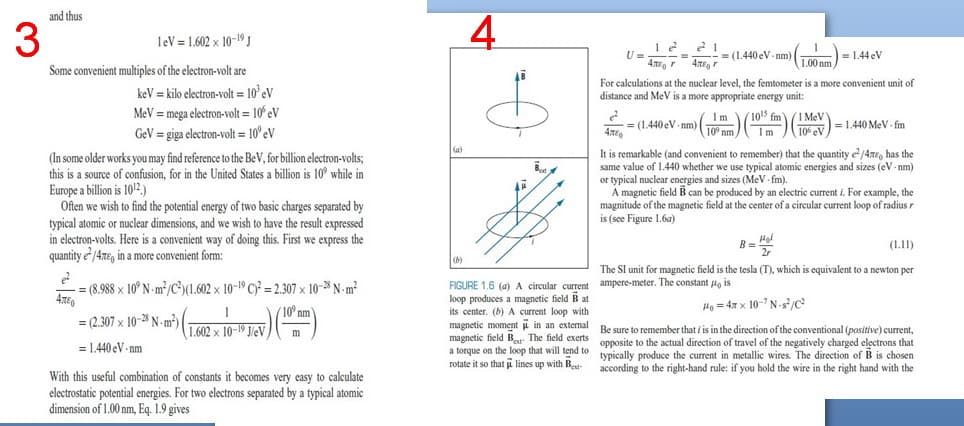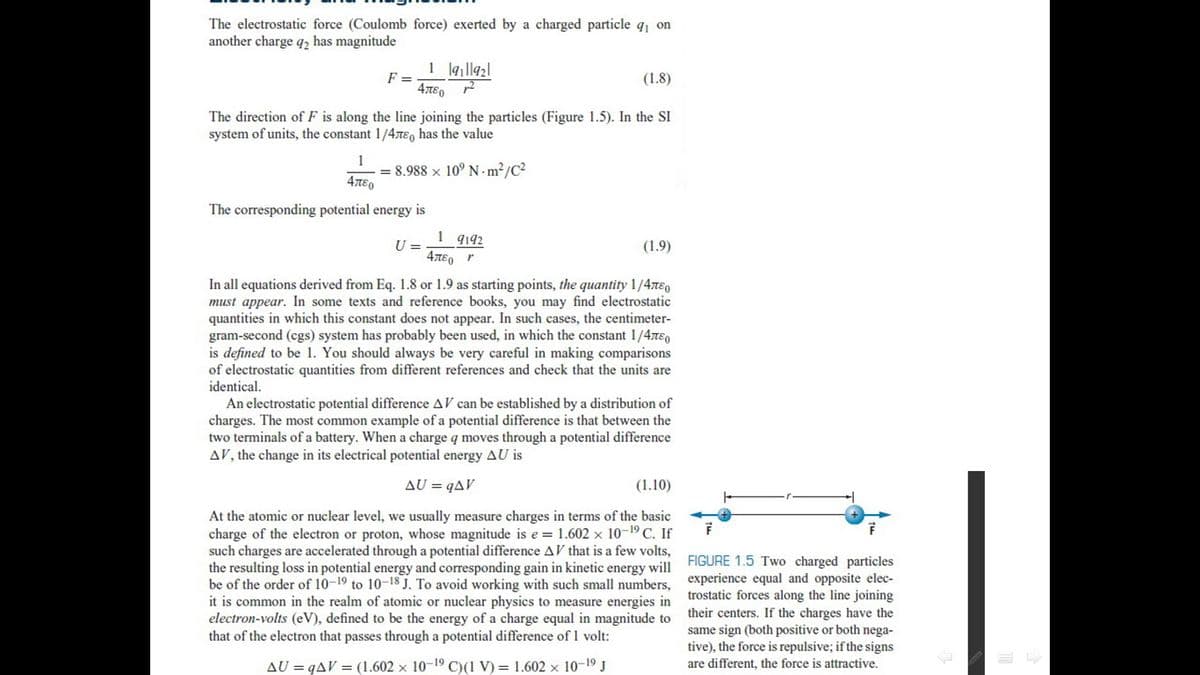Define the electric field of a single charge and the magnetic force acting on a moving electric charge using the definitions and formulas in the photos.
Define the electric field of a single charge and the magnetic force acting on a moving electric charge using the definitions and formulas in the photos.
Modern Physics
3rd Edition
ISBN:9781111794378
Author:Raymond A. Serway, Clement J. Moses, Curt A. Moyer
Publisher:Raymond A. Serway, Clement J. Moses, Curt A. Moyer
Chapter2: Relativity Ii
Section: Chapter Questions
Problem 4P: A charged particle moves along a straight line in a uniform electric field E with a speed v. If the...
Related questions
Question
100%
Define the electric field of a single charge and the magnetic force acting on a moving electric charge using the definitions and formulas in the photos.

Transcribed Image Text:and thus
3
4
leV = 1.602 x 10-19 J
U =
4TE, r
-= (1.440 eV- nm)
4TE, r
= 1.44 eV
1.00 nm
Some convenient multiples of the electron-volt are
keV = kilo electron-volt = 10' eV
MeV = mega electron-volt = 10 eV
For calculations at the nuclear level, the femtometer is a more convenient unit of
distance and MeV is a more appropriate energy unit:
(1 MeV
10 eV
= (1.440 eV nm)
= 1.440 MeV fm
GeV = giga electron-volt = 10° eV
10° nm
Im
It is remarkable (and convenient
same value of 1.440 whether we use typical atomic energies and sizes (eV- nm)
or typical nuclear energies and sizes (MeV fm).
A magnetic field B can be produced by an electric current i. For example, the
magnitude of the magnetic field at the center of a circular current loop of radius r
is (see Figure 1.6a)
remember) that the quantity e/4xe, has the
(In some older works you may find reference to the BeV, for billion electron-volts;
this is a source of confusion, for in the United States a billion is 10° while in
Europe a billion is 1012 )
Ofen we wish to find the potential energy of two basic charges separated by
typical atomic or nuclear dimensions, and we wish to have the result expressed
in electron-volts. Here is a convenient way of doing this. First we express the
quantity e /4ne, in a more convenient form:
(1.11)
The SI unit for magnetic field is the tesla (T), which is equivalent to a newton per
FIGURE 1.6 (a)A circular current ampere-meter. The constant ao is
loop produces a magnetic field B at
its center. (b) A current loop with
magnetic moment i in an external
magnetic field B The field exerts
a torque on the loop that will tend to typically produce the current in metallic wires. The direction of B is chosen
rotate it so that i lines up with Bet-
= (8.988 x 10° N- m/c³)(1.602 x 10-19 C = 2.307 x 10- N- m?
Ho = 4x x 10- N-s/C
10" nm
= (2.307 x 10-28 N - m²)
1.602 x 10-19 JleV
Be sure to remember that i is in the direction of the conventional (positive) current,
opposite to the actual direction of travel of the negatively charged electrons that
= 1.440 eV - nm
according to the right-hand rule: if you hold the wire in the right hand with the
With this useful combination of constants it becomes very easy to calculate
electrostatic potential energies. For two electrons separated by a typical atomic
dimension of 1.00 nm, Eq. 1.9 gives

Transcribed Image Text:The electrostatic force (Coulomb force) exerted by a charged particle q, on
another charge q2 has magnitude
1 9 ll92|
F =
4πεο r
(1.8)
The direction of F is along the line joining the particles (Figure 1.5). In the SI
system of units, the constant 1/4TE, has the value
1
= 8.988 x 10° N - m²/C2
The corresponding potential energy is
U =
1 4192
(1.9)
4πεο r
In all equations derived from Eq. 1.8 or 1.9 as starting points, the quantity 1/4xE,
must appear. In some texts and reference books, you may find electrostatic
quantities in which this constant does not appear. In such cases, the centimeter-
gram-second (cgs) system has probably been used, in which the constant 1/4TE,
is defined to be 1. You should always be very careful in making comparisons
of electrostatic quantities from different references and check that the units are
identical.
An electrostatic potential difference AV can be established by a distribution of
charges. The most common example of a potential difference is that between the
two terminals of a battery. When a charge q moves through a potential difference
AV, the change in its electrical potential energy AU is
AU = qAV
(1.10)
At the atomic or nuclear level, we usually measure charges in terms of the basic
charge of the electron or proton, whose magnitude is e = 1.602 x 10-19 C. If
such charges are accelerated through a potential difference AV that is a few volts,
the resulting loss in potential energy and corresponding gain in kinetic energy will
be of the order of 10-19 to 10-18 J. To avoid working with such small numbers. experience equal and opposite elec-
it is common in the realm of atomic or nuclear physics to measure energies in
electron-volts (eV), defined to be the energy of a charge equal in magnitude to
that of the electron that passes through a potential difference of 1 volt:
FIGURE 1.5 Two charged particles
trostatic forces along the line joining
their centers. If the charges have the
same sign (both positive or both nega-
tive), the force is repulsive; if the signs
are different, the force is attractive.
AU = qAV = (1.602 x 10-19 C)(1 V) = 1.602 × 10-19 J
Expert Solution
This question has been solved!
Explore an expertly crafted, step-by-step solution for a thorough understanding of key concepts.
This is a popular solution!
Trending now
This is a popular solution!
Step by step
Solved in 2 steps

Knowledge Booster
Learn more about
Need a deep-dive on the concept behind this application? Look no further. Learn more about this topic, physics and related others by exploring similar questions and additional content below.Recommended textbooks for you

Modern Physics
Physics
ISBN:
9781111794378
Author:
Raymond A. Serway, Clement J. Moses, Curt A. Moyer
Publisher:
Cengage Learning

Modern Physics
Physics
ISBN:
9781111794378
Author:
Raymond A. Serway, Clement J. Moses, Curt A. Moyer
Publisher:
Cengage Learning